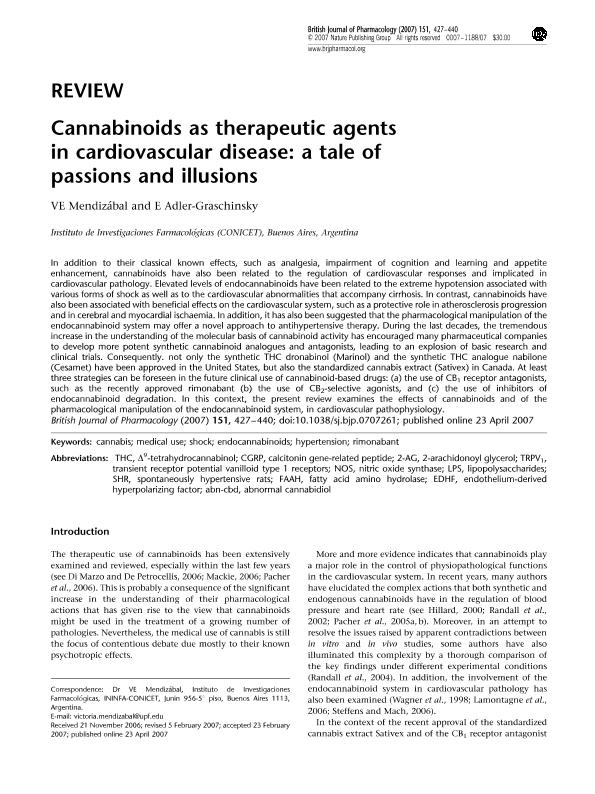Mostrar el registro sencillo del ítem
dc.contributor.author
Mendizabal, Victoria Eugenia

dc.contributor.author
Adler, Edda

dc.date.available
2020-01-08T22:09:10Z
dc.date.issued
2007-06
dc.identifier.citation
Mendizabal, Victoria Eugenia; Adler, Edda; Cannabinoids as therapeutic agents in cardiovascular disease: A tale of passions and illusions; Wiley Blackwell Publishing, Inc; British Journal of Pharmacology; 151; 4; 6-2007; 427-440
dc.identifier.issn
0007-1188
dc.identifier.uri
http://hdl.handle.net/11336/94092
dc.description.abstract
In addition to their classical known effects, such as analgesia, impairment of cognition and learning and appetite enhancement, cannabinoids have also been related to the regulation of cardiovascular responses and implicated in cardiovascular pathology. Elevated levels of endocannabinoids have been related to the extreme hypotension associated with various forms of shock as well as to the cardiovascular abnormalities that accompany cirrhosis. In contrast, cannabinoids have also been associated with beneficial effects on the cardiovascular system, such as a protective role in atherosclerosis progression and in cerebral and myocardial ischaemia. In addition, it has also been suggested that the pharmacological manipulation of the endocannabinoid system may offer a novel approach to antihypertensive therapy. During the last decades, the tremendous increase in the understanding of the molecular basis of cannabinoid activity has encouraged many pharmaceutical companies to develop more potent synthetic cannabinoid analogues and antagonists, leading to an explosion of basic research and clinical trials. Consequently. not only the synthetic THC dronabinol (Marinol) and the synthetic THC analogue nabilone (Cesamet) have been approved in the United States, but also the standardized cannabis extract (Sativex) in Canada. At least three strategies can be foreseen in the future clinical use of cannabinoid-based drugs: (a) the use of CB 1 receptor antagonists, such as the recently approved rimonabant (b) the use of CB 2-selective agonists, and (c) the use of inhibitors of endocannabinoid degradation. In this context, the present review examines the effects of cannabinoids and of the pharmacological manipulation of the endocannabinoid system, in cardiovascular pathophysiology.
dc.format
application/pdf
dc.language.iso
eng
dc.publisher
Wiley Blackwell Publishing, Inc

dc.rights
info:eu-repo/semantics/openAccess
dc.rights.uri
https://creativecommons.org/licenses/by-nc-sa/2.5/ar/
dc.subject
CANNABIS
dc.subject
ENDOCANNABINOIDS
dc.subject
HYPERTENSION
dc.subject
MEDICAL USE
dc.subject
RIMONABANT
dc.subject
SHOCK
dc.subject.classification
Neurociencias

dc.subject.classification
Medicina Básica

dc.subject.classification
CIENCIAS MÉDICAS Y DE LA SALUD

dc.title
Cannabinoids as therapeutic agents in cardiovascular disease: A tale of passions and illusions
dc.type
info:eu-repo/semantics/article
dc.type
info:ar-repo/semantics/artículo
dc.type
info:eu-repo/semantics/publishedVersion
dc.date.updated
2019-11-25T17:47:18Z
dc.journal.volume
151
dc.journal.number
4
dc.journal.pagination
427-440
dc.journal.pais
Reino Unido

dc.journal.ciudad
Londres
dc.description.fil
Fil: Mendizabal, Victoria Eugenia. Consejo Nacional de Investigaciones Científicas y Técnicas. Oficina de Coordinación Administrativa Houssay. Instituto de Investigaciones Farmacológicas. Universidad de Buenos Aires. Facultad de Farmacia y Bioquímica. Instituto de Investigaciones Farmacológicas; Argentina
dc.description.fil
Fil: Adler, Edda. Consejo Nacional de Investigaciones Científicas y Técnicas. Oficina de Coordinación Administrativa Houssay. Instituto de Investigaciones Farmacológicas. Universidad de Buenos Aires. Facultad de Farmacia y Bioquímica. Instituto de Investigaciones Farmacológicas; Argentina
dc.journal.title
British Journal of Pharmacology

dc.relation.alternativeid
info:eu-repo/semantics/altIdentifier/doi/https://doi.org/10.1038/sj.bjp.0707261
dc.relation.alternativeid
info:eu-repo/semantics/altIdentifier/url/https://www.ncbi.nlm.nih.gov/pmc/articles/PMC2013961/
dc.relation.alternativeid
info:eu-repo/semantics/altIdentifier/url/https://bpspubs.onlinelibrary.wiley.com/doi/full/10.1038/sj.bjp.0707261
Archivos asociados
